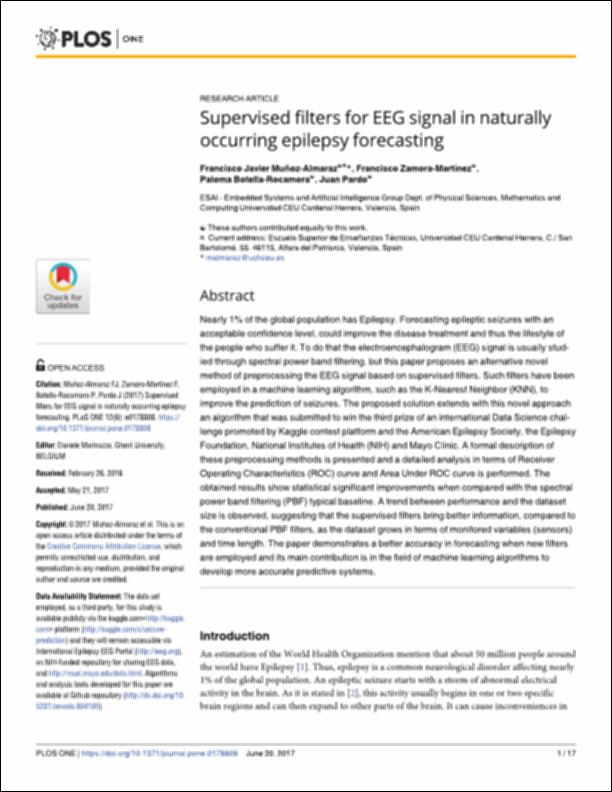Please use this identifier to cite or link to this item:
http://hdl.handle.net/10637/13367Supervised filters for EEG signal in naturally occurring epilepsy forecasting
| Title: | Supervised filters for EEG signal in naturally occurring epilepsy forecasting |
| Authors : | Muñoz Almaraz, Francisco Javier Zamora Martínez, Francisco Botella Rocamora, Paloma María Pardo Albiach, Juan |
| Keywords: | Epilepsy - Prediction (Statistics); Epilepsy - Mathematical models.; Epilepsia - Tratamiento.; Epilepsia - Modelos matemáticos.; Epilepsia - Predicción (Estadística); Electroencefalografía.; Electroencephalography.; Epilepsy - Treatment. |
| Publisher: | PLOS |
| Citation: | Muñoz-Almaraz, F.J., Zamora-Martínez, F., Botella-Rocamora, P. & Pardo, J. (2017). Supervised filters for EEG signal in naturally occurring epilepsy forecasting. PLoS ONE, vol. 12, i. 6 (20 jun.), art. e0178808. DOI: https://doi.org/10.1371/journal.pone.0178808 |
| Abstract: | Nearly 1% of the global population has Epilepsy. Forecasting epileptic seizures with an acceptable confidence level, could improve the disease treatment and thus the lifestyle of the people who suffer it. To do that the electroencephalogram (EEG) signal is usually studied through spectral power band filtering, but this paper proposes an alternative novel method of preprocessing the EEG signal based on supervised filters. Such filters have been employed in a machine learning algorithm, such as the K-Nearest Neighbor (KNN), to improve the prediction of seizures. The proposed solution extends with this novel approach an algorithm that was submitted to win the third prize of an international Data Science challenge promoted by Kaggle contest platform and the American Epilepsy Society, the Epilepsy Foundation, National Institutes of Health (NIH) and Mayo Clinic. A formal description of these preprocessing methods is presented and a detailed analysis in terms of Receiver Operating Characteristics (ROC) curve and Area Under ROC curve is performed. The obtained results show statistical significant improvements when compared with the spectral power band filtering (PBF) typical baseline. A trend between performance and the dataset size is observed, suggesting that the supervised filters bring better information, compared to the conventional PBF filters, as the dataset grows in terms of monitored variables (sensors) and time length. The paper demonstrates a better accuracy in forecasting when new filters are employed and its main contribution is in the field of machine learning algorithms to develop more accurate predictive systems. |
| Description: | Este artículo se encuentra disponible en la siguiente URL: https://journals.plos.org/plosone/article?id=10.1371/journal.pone.0178808 |
| URI: | http://hdl.handle.net/10637/13367 |
| Rights : | http://creativecommons.org/licenses/by/4.0/deed.es |
| ISSN: | 1932-6203 (Electrónico) |
| Issue Date: | 20-Jun-2017 |
| Center : | Universidad Cardenal Herrera-CEU |
| Appears in Collections: | Dpto. Matemáticas, Física y Ciencias Tecnológicas |
Items in DSpace are protected by copyright, with all rights reserved, unless otherwise indicated.


